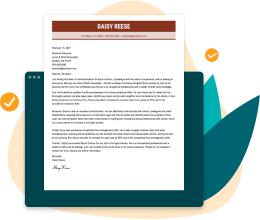How to List a Degree on a Resume for 2025
Make your well-earned degree really count when writing your resume and searching for a job. We’ll show you how to list a degree on a resume including associate, bachelor’s, master’s and doctorate degrees correctly, including special cases like an incomplete degree or GED.
TABLE OF CONTENTS
Want to save time and create a resume fast? Our Resume Builder will tailor your resume to the desired role, and write your education section with degrees for you. Simply pick a resume template and have your resume done in minutes!
How to list a degree on
a resume
For some roles, having the right degree or education is required. We’ll show you how to list a degree on a resume the right way.
Regardless of your degree type, you should include the same vital bits when learning how to list a degree on a resume.
For all degrees you list, you need to include the following:
- University name
- Degree obtained
- Major
- Minor (if applicable)
- Year completed
Your resume education section should come before or after your work history section. List multiple degrees in reverse-chronological order, starting with your most recent degree and then going backward.
When should you list a degree on
a resume?
You should include any degree you’ve completed, even if it doesn’t seem to relate to the role directly. It’ll show your background, interests, skills and hard work.
List a degree on a resume in the education section.
If you’re fresh out of school, a college student or graduated within the past two years, your education can be near the top of your resume. That will give it more focus if you don’t have much work experience.
However, if you’ve worked in your field for a few years, the education section should live at the bottom of your resume.
SEE MORE
Where to include your education section based on resume format. Depending on your level of experience, you’ll choose among three formats: chronological, functional or combination.
Now, if you’re ready to get started writing your resume check out our best tool, our Resume Builder. It comes pre-loaded with resume templates for every job and industry.
It can help you create a resume in just 15 minutes because it automates the whole process for you! It’s like having an expert walk you through step-by-step.
How to list an associate
degree on a resume
Education
Santa Barbara Community College, Santa Barbara, CA Associate of Arts in Sociology
An associate degree is the first level of certification that many colleges provide. It’s a step below a bachelor’s degree and usually takes around two years of study to complete.
To list an associate degree, you need this basic information: institution name, city/state location, degree and major(s).
To avoid confusion, spell out the full name of your degree rather than abbreviate it. There are many ways that degrees may be abbreviated, which may be obscure to some recruiter reading your resume.
The one exception to this is if you’re running out of space on your resume; then use the abbreviation.
- AA (Associate of Arts)
- AAB (Associate of Applied Business)
- ABA (Associate of Business Administration)
- AAT (Associate of Arts in Teaching)
- AAS (Associate in Applied Science)
- AS (Associate in Science)
- ASN (Associate of Nursing)
How to list a bachelor’s
degree on a resume
Education
Pomona College, Claremont, CA
Bachelor of Science in Engineering
A bachelor’s degree is a standard undergraduate degree most people earn with four to five years of full-time study.
Like any degree, you should list your bachelor’s degree on a resume in the education section.
You should put the full name of your degree on a resume to ensure everything is clear. However, you may use an abbreviation instead if you’re short for space.
- BA (Bachelor of Arts)
- BS (Bachelor of Science)
Aside from those two most common, there are other special bachelor’s degrees.
- BBA (Bachelor of Business Administration)
- BEd (Bachelor of Education)
- BJHum (Bachelor of Journalism and Humanities)
- BLA (Bachelor of Liberal Arts)
- BMPD (Bachelor of Media Production and Design)
- BMusA (Bachelor of Musical Arts)
- BPAPM (Bachelor of Public Affairs and Policy Management)
- BScFS (Bachelor of Science in Forensic Science)
- BSW (Bachelor of Social Work)
Employers are likely familiar with the degree abbreviations if the job you’re applying for is in one of these fields.
However, it’s always best to spell it out if you have the space! If a recruiter doesn’t understand an abbreviation, you may be underselling yourself.
How to list a master’s degree
on a resume
Education
Cooper Union, New York, NY
Master of Fine Arts
Parsons School of Design, New York, NY
Bachelor of Arts: Illustration
A master’s degree, often called a “graduate degree,” is an academic degree awarded by a university or college after completing a bachelor’s degree.
Every master’s program varies, but it usually takes around two years to complete.
Write a master’s degree on your resume in the education section. Like in the above example, list your master’s (most recent) degree above your bachelor’s.
- AM, MA (Master of Arts)
- MBA (Master of Business Administration)
- ME, MEng, M.Eng. (Master of Engineering)
- MEd (Master of Education)
- MIB (Master of International Business)
- MS, MSc (Master of Science)
- MSMet (Master of Science in Metallurgical Engineering)
Like other degrees, you can abbreviate your master’s degree on a resume. However, if you have the space, it’s better to spell it out to avoid confusion.
How to list a doctorate
degree on a resume
Education
The University of Illinois, Urbana-Champaign, IL
Ph.D. Macromolecular Science and Engineering
Thesis: A Bibliometric Study of Polymer Science
Advisor: Dr. Jenna Andersen
The University of Michigan, Ann Arbor, MI
MS Macromolecular Science and Engineering
Western Michigan University, Kalamazoo, MI
BS Concentration in Chemistry
A doctorate or Ph.D. is the highest academic degree awarded.
Ph.D. stands for philosophiae doctor or “doctor of philosophy” and applies to more than doctors and medical professionals. For example, you could also have a Ph.D. in mathematics or art history.
It means that you have a high level of mastery over the subject matter and are qualified to teach. It can take time to complete a Ph.D., anywhere from three to 10+ years.
Like with a master’s degree, if you list a Ph.D., do so in reverse-chronological order. That means you should have your most recent degree first and anything you earned before it underneath, like in the above example.
Listing a doctorate often includes extra details like your thesis topic and academic advisor.
Just like other degrees, doctorate degrees are sometimes abbreviated on a resume to save space.
- DMin (Doctor of Ministry)
- DMus, MusD (Doctor of Music)
- DNursSc (Doctor of Nursing Science)
- DPT (Doctor of Physical Therapy)
- DPsych (Doctor of Psychology)
- DrPH (Doctor of Public Health)
- DSW (Doctor of Social Work)
- ThD (Doctor of Theology)
How to list a degree on a resume: incomplete or
in-progress degree
In-progress degree example:
Mills College, Oakland, CA
Expected graduation date: 2025: BA in Psychology
Incomplete degree resume example:
Amherst College, Amherst, MA 2019-2021
Completed 65 credits toward BA in Political Science
If your degree is in progress or you’ve taken a break from it, you can still list it on your resume.
However, you need to show that it’s incomplete by either mentioning your expected graduation date (if it’s in progress) or the number of credit hours you completed (if you stopped your education).
That way, an employer can consider your educational background and progress. It will help more than not including it at all!
How to list a high school diploma
on your resume
You should only list your high school diploma if you haven’t earned a higher degree or certificate or if you’re a high school graduate writing a resume for college.
- The name of the institution
- Its city/state location
- The year you graduated or earned your GED (if less than five years ago)
Hopefully, that answers all of your questions about adding degrees to your resume education section.
If you’re ready to jumpstart the writing process, make use of our Resume Builder. It’s the fastest way to create a resume from scratch, and get past those pesky applicant tracking systems (ATS) employers use to scan your resume!
Pair your resume with a great cover letter to get an edge over the competition. Our Cover Letter Generator will tailor your letter to the desired role and features professionally written content, cover letter templates and cover letter examples to perfect your application.
How to list a degree on a resume FAQ
Should I include all degrees on a resume?
Yes. If you’ve earned a degree past high school, always include it on your resume.
It will help to show employers that you’re educated, hard-working and follow through on your goals even if you have no work experience.
Omit your high school education if you’ve attended any college.
Should I list the year I earned my degree?
It was standard to always include your graduation date when listing a degree on your resume.
Today, this is not good practice because it gives an employer a hint about your age which can lead to hiring bias issues.
Follow these guidelines: If you just completed your degree in the past few years, including the date you graduated is OK.
However, it’s better to leave dates off your resume if it’s been over five years since you completed your degree.
The only other exception is if you haven’t completed your degree! In this case, it’s best practice to cite the “Expected graduation date:” and the year you expect to finish your degree.
Should I include my GPA or academic honors when listing my degree?
In some cases, yes. But not always, especially if you graduated over five years ago.
If your GPA is solid or you graduated with honors, such as magna cum laude or summa cum laude, it could impress employers to include this information.
However, the flip side is that if you’ve been out of school for a long time (five or more years), including this information could appear like you’re hanging on to old achievements.
Does a high school diploma count as a degree?
Technically speaking, no. A high school diploma is a certificate and not a degree.
The word “degree” is more specific to college-level achievements.
It can be confusing because sometimes a GED, General Educational Development test, is incorrectly called a “General Education Diploma” or “General Education Degree.” Spelling out the abbreviations in these ways is incorrect.
Featured in:*

*The names and logos of the companies referred to in this page are all trademarks of their respective holders. Unless specifically stated otherwise, such references are not intended to imply any affiliation or association with LiveCareer.






